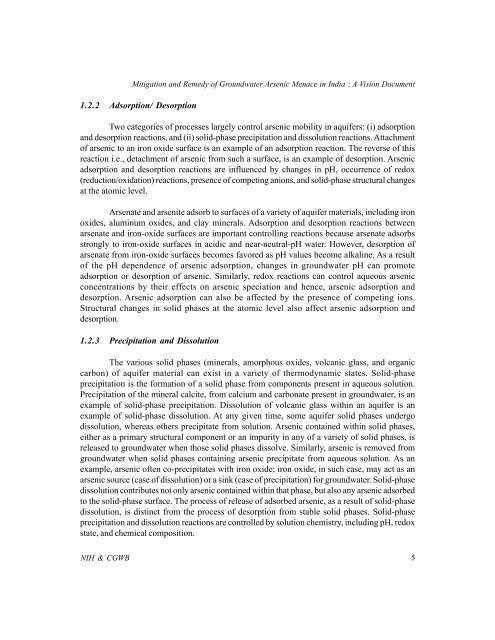Mitigation and Remedy of Groundwater Arsenic Menace in India
Mitigation and Remedy of Groundwater Arsenic Menace in India
Mitigation and Remedy of Groundwater Arsenic Menace in India
Create successful ePaper yourself
Turn your PDF publications into a flip-book with our unique Google optimized e-Paper software.
<strong>Mitigation</strong> <strong>and</strong> <strong>Remedy</strong> <strong>of</strong> <strong>Groundwater</strong> <strong>Arsenic</strong> <strong>Menace</strong> <strong>in</strong> <strong>India</strong> : A Vision Document1.2.2 Adsorption/ DesorptionTwo categories <strong>of</strong> processes largely control arsenic mobility <strong>in</strong> aquifers: (i) adsorption<strong>and</strong> desorption reactions, <strong>and</strong> (ii) solid-phase precipitation <strong>and</strong> dissolution reactions. Attachment<strong>of</strong> arsenic to an iron oxide surface is an example <strong>of</strong> an adsorption reaction. The reverse <strong>of</strong> thisreaction i.e., detachment <strong>of</strong> arsenic from such a surface, is an example <strong>of</strong> desorption. <strong>Arsenic</strong>adsorption <strong>and</strong> desorption reactions are <strong>in</strong>fluenced by changes <strong>in</strong> pH, occurrence <strong>of</strong> redox(reduction/oxidation) reactions, presence <strong>of</strong> compet<strong>in</strong>g anions, <strong>and</strong> solid-phase structural changesat the atomic level.Arsenate <strong>and</strong> arsenite adsorb to surfaces <strong>of</strong> a variety <strong>of</strong> aquifer materials, <strong>in</strong>clud<strong>in</strong>g ironoxides, alum<strong>in</strong>um oxides, <strong>and</strong> clay m<strong>in</strong>erals. Adsorption <strong>and</strong> desorption reactions betweenarsenate <strong>and</strong> iron-oxide surfaces are important controll<strong>in</strong>g reactions because arsenate adsorbsstrongly to iron-oxide surfaces <strong>in</strong> acidic <strong>and</strong> near-neutral-pH water. However, desorption <strong>of</strong>arsenate from iron-oxide surfaces becomes favored as pH values become alkal<strong>in</strong>e. As a result<strong>of</strong> the pH dependence <strong>of</strong> arsenic adsorption, changes <strong>in</strong> groundwater pH can promoteadsorption or desorption <strong>of</strong> arsenic. Similarly, redox reactions can control aqueous arsenicconcentrations by their effects on arsenic speciation <strong>and</strong> hence, arsenic adsorption <strong>and</strong>desorption. <strong>Arsenic</strong> adsorption can also be affected by the presence <strong>of</strong> compet<strong>in</strong>g ions.Structural changes <strong>in</strong> solid phases at the atomic level also affect arsenic adsorption <strong>and</strong>desorption.1.2.3 Precipitation <strong>and</strong> DissolutionThe various solid phases (m<strong>in</strong>erals, amorphous oxides, volcanic glass, <strong>and</strong> organiccarbon) <strong>of</strong> aquifer material can exist <strong>in</strong> a variety <strong>of</strong> thermodynamic states. Solid-phaseprecipitation is the formation <strong>of</strong> a solid phase from components present <strong>in</strong> aqueous solution.Precipitation <strong>of</strong> the m<strong>in</strong>eral calcite, from calcium <strong>and</strong> carbonate present <strong>in</strong> groundwater, is anexample <strong>of</strong> solid-phase precipitation. Dissolution <strong>of</strong> volcanic glass with<strong>in</strong> an aquifer is anexample <strong>of</strong> solid-phase dissolution. At any given time, some aquifer solid phases undergodissolution, whereas others precipitate from solution. <strong>Arsenic</strong> conta<strong>in</strong>ed with<strong>in</strong> solid phases,either as a primary structural component or an impurity <strong>in</strong> any <strong>of</strong> a variety <strong>of</strong> solid phases, isreleased to groundwater when those solid phases dissolve. Similarly, arsenic is removed fromgroundwater when solid phases conta<strong>in</strong><strong>in</strong>g arsenic precipitate from aqueous solution. As anexample, arsenic <strong>of</strong>ten co-precipitates with iron oxide; iron oxide, <strong>in</strong> such case, may act as anarsenic source (case <strong>of</strong> dissolution) or a s<strong>in</strong>k (case <strong>of</strong> precipitation) for groundwater. Solid-phasedissolution contributes not only arsenic conta<strong>in</strong>ed with<strong>in</strong> that phase, but also any arsenic adsorbedto the solid-phase surface. The process <strong>of</strong> release <strong>of</strong> adsorbed arsenic, as a result <strong>of</strong> solid-phasedissolution, is dist<strong>in</strong>ct from the process <strong>of</strong> desorption from stable solid phases. Solid-phaseprecipitation <strong>and</strong> dissolution reactions are controlled by solution chemistry, <strong>in</strong>clud<strong>in</strong>g pH, redoxstate, <strong>and</strong> chemical composition.NIH & CGWB 5




